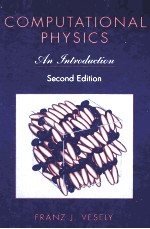

COMPUTATIONAL PHYSICS AN INTRODUCTION SECOND EDITIONPDF电子书下载
- 电子书积分:11 积分如何计算积分?
- 作 者:
- 出 版 社:KLUWER ACADEMIC/PLENUM PUBLISHERS NEW YORK
- 出版年份:2001
- ISBN:0306466317
- 页数:259 页
Ⅰ The Three Pillars of Computational Physics 1
1 Finite Differences 7
1.1 Interpolation Formulae 9
1.1.1 NGF Interpolation 9
1.1.2 NGB Interpolation 10
1.1.3 ST Interpolation 11
1.2 Difference Quotients 12
1.2.1 DNGF Formulae 12
1.2.2 DNGB Formulae 14
1.2.3 DST Formulae 15
1.3 Finite Differences in Two Dimensions 17
1.4 Sample Applications 18
1.4.1 Classical Point Mechanics 18
1.4.2 Diffusion and Thermal Conduction 19
2 Linear Algebra 21
2.1 Exact Methods 22
2.1.1 Gauss Elimination and Back Substitution 22
2.1.2 Simplifying Matrices: The Householder Transformation 25
2.1.3 LU Decomposition 26
2.1.4 Tridiagonal Matrices: Recursion Method 29
2.2 Iterative Methods 31
2.2.1 Jacobi Relaxation 32
2.2.2 Gauss-Seidel Relaxation (GSR) 34
2.2.3 Successive Over-Relaxation (SOR) 34
2.2.4 Alternating Direction Implicit Method (ADI) 36
2.2.5 Conjugate Gradient Method (CG) 36
2.3 Eigenvalues and Eigenvectors 40
2.3.1 Largest Eigenvalue and Related Eigenvector 40
2.3.2 Arbitrary Eigenvalue/-vector: Inverse Iteration 42
2.4 Sample Applications 43
2.4.1 Diffusion and Thermal Conduction 43
2.4.2 Potential Equation 44
2.4.3 Electronic Orbitals 45
3 Stochastics 47
3.1 Equidistributed Random Variates 49
3.1.1 Linear Congruential Generators 49
3.1.2 Shift Register Generators 50
3.2 Other Distributions 53
3.2.1 Fundamentals 53
3.2.2 Transformation Method 56
3.2.3 Generalized Transformation Method: 57
3.2.4 Rejection Method 59
3.2.5 Multivariate Gaussian Distribution 62
3.2.6 Equidistribution in Orientation Space 66
3.3 Random Sequences 68
3.3.1 Fundamentals 68
3.3.2 Markov Processes 71
3.3.3 Autoregressive Processes 74
3.3.4 Wiener-Levy Process 77
3.3.5 Markov Chains and the Monte Carlo method 78
3.4 Stochastic Optimization 80
3.4.1 Simulated Annealing 81
3.4.2 Genetic Algorithms 82
Ⅱ Everything Flows 85
4 Ordinary Differential Equations 89
4.1 Initial Value Problems of First Order 90
4.1.1 Euler-Cauchy Algorithm 90
4.1.2 Stability and Accuracy of Difference Schemes 91
4.1.3 Explicit Methods 94
4.1.4 Implicit Methods 96
4.1.5 Predictor-Corrector Method 98
4.1.6 Runge-Kutta Method 101
4.1.7 Extrapolation Method 104
4.2 Initial Value Problems of Second Order 105
4.2.1 Verlet Method 105
4.2.2 Predictor-Corrector Method 108
4.2.3 Nordsieck Formulation of the PC Method 110
4.2.4 Runge-Kutta Method 112
4.2.5 Symplectic Algorithms 112
4.2.6 Numerov’s Method 117
4.3 Boundary Value Problems 119
4.3.1 Shooting Method 120
4.3.2 Relaxation Method 121
5 Partial Differential Equations 125
5.1 Initial Value Problems I (Hyperbolic) 129
5.1.1 FTCS Scheme; Stability Analysis 129
5.1.2 Lax Scheme 131
5.1.3 Leapfrog Scheme (LF) 133
5.1.4 Lax-Wendroff Scheme (LW) 135
5.1.5 Lax and Lax-Wendroff in Two Dimensions 135
5.2 Initial Value Problems 11 (Parabolic) 138
5.2.1 FTCS Scheme 138
5.2.2 Implicit Scheme of First Order 140
5.2.3 Crank-Nicholson Scheme (CN) 141
5.2.4 Dufort-Frankel Scheme (DF) 143
5.3 Boundary Value Problems: Elliptic DE 143
5.3.1 Relaxation and Multigrid Techniques 147
5.3.2 ADI Method for the Potential Equation 148
5.3.3 Fourier Transform Method (FT) 150
5.3.4 Cyclic Reduction (CR) 153
Ⅲ Anchors Aweigh 157
6 Simulation and Statistical Mechanics 161
6.1 Model Systems of Statistical Mechanics 164
6.1.1 A Nutshellfull of Fluids and Solids 164
6.1.2 Tricks of the Trade 168
6.2 Monte Carlo Method 171
6.3 Molecular Dynamics Simulation 175
6.3.1 Hard Spheres 175
6.3.2 Continuous Potentials 177
6.3.3 Beyond Basic Molecular Dynamics 178
6.4 Evaluation of Simulation Experiments 181
6.4.1 Pair Correlation Function 182
6.4.2 Autocorrelation Functions 184
6.5 Particles and Fields 185
6.5.1 Ewald summation 186
6.5.2 Particle-Mesh Methods (PM and P3M): 188
6.6 Stochastic Dynamics 191
7 Quantum Mechanical Simulation 195
7.1 Diffusion Monte Carlo (DMC) 196
7.2 Path Integral Monte Carlo (PIMC) 201
7.3 Wave Packet Dynamics (WPD) 209
7.4 Density Functional Molecular Dynamics(DFMD) 211
8 Hydrodynamics 215
8.1 Compressible Flow without Viscosity 216
8.1.1 Explicit Eulerian Methods 217
8.1.2 Particle-in-Cell Method (PIC) 218
8.1.3 Smoothed Particle Hydrodynamics (SPH) 220
8.2 Incompressible Flow with Viscosity 226
8.2.1 Vorticity Method 227
8.2.2 Pressure Method 229
8.2.3 Free Surfaces: Marker-and-Cell Method (MAC) 231
8.3 Lattice Gas Models for Hydrodynamics 232
8.3.1 Lattice Gas Cellular Automata 232
8.3.2 The Lattice Boltzmann Method 236
8.4 Direct Simulation Monte Carlo / Bird method 237
Appendixes 239
A Machine Errors 241
B Discrete Fourier Transformation 245
B.1 Fundamentals 245
B.2 Fast Fourier Transform (FFT) 246
Bibliography 249
Index 257
- 《大学英文写作 第3册 第3版=ACADEMIC WRITING FOR ENGLISH MAJORS WRITING A RESEARCH PAPER》丁言仁主编 2020
- 《当代中国美学学术史》李修建,刘悦笛著 2013
- 《相贱有逆》杜子藤著 2012
- 《IELTS阅读模拟试题集 Academic》尹陈毅,陈晓莹编著 2003
- 《失落的精神家园 发展中与中等收入国家大学教授职业透视 The academic profession in developing and middle-income countries》(美)菲利普·G.阿特巴赫(Philip G.Altbach)主编;施晓光主译 2006
- 《留学,就这些了!》曹文,沈忆文主编 2011
- 《雅思单词有秘密》蒋志榆著 2017
- 《时代焦点英语学习丛书 新挑战TOEFL iBT作文满分》许轶(斯坦福大学MBA)编著;RenzoBrundelRe,JalubTucholski顾问 2013
- 《综合学术英语教程 4》蔡基刚主编 2014
- 《工程学科英语》乔小六主编;龚玲莉,孙梓健副主编;李士芹,曹磊,曹永俐编写;徐莉芳主审 2015
